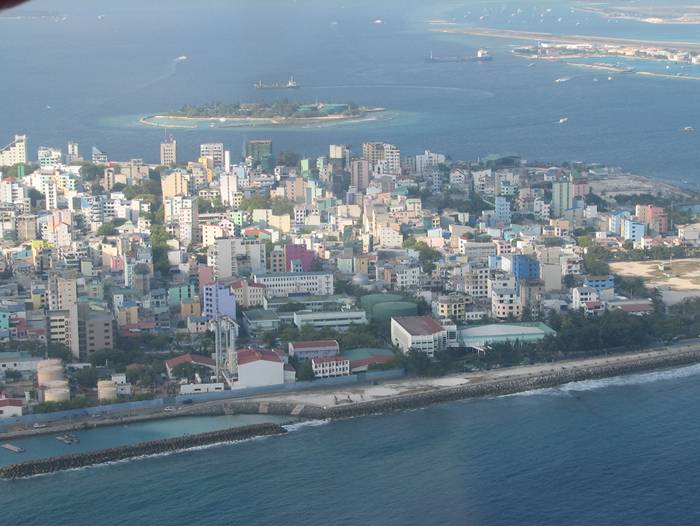Male Island — Kaafu Atoll
Malé, is the capital and most populous city in the Republic of Maldives.
It is located at the southern edge of North Malé Atoll (Kaafu Atoll).
It is also one of the Administrative divisions of the Maldives.
Traditionally it was the King's Island, from where the ancient Maldive
Royal dynasties ruled and where the palace was located. The city was
also called Mahal. Formerly it was a walled city surrounded by
fortifications and gates (doroshi). The Royal Palace (Gan'duvaru) was
destroyed along with the picturesque forts (kotte) and bastions (buruzu)
when the city was remodelled under President Ibrahim Nasir's rule after
the abolition of the monarchy. However, the beautifully decorated Male'
Hukuru Miskiy remains. In recent years, the island has been
considerably expanded through landfilling operations. Over the years
there have been many coup attempts and protests centered in Male as a
result of demand for greater democracy in the Maldives.
Photo — Link
The whole island group, the Maldives, is named after its capital. The
word "Maldives" means "The islands (dives) of Male'". The first settlers
in the Maldive islands were Dravidian people from the nearest shores,
which are in the modern Indian Subcontinent and coastal Ceylon.
Comparative studies of Maldivian linguistic, oral and other cultural
traditions, in addition to folklore, point to a strong Dravidian
influence on Maldivian society, centered in Malé, from ancient times.
The people of Giraavaru, an island located in Malé Atoll (now a tourist
resort, after the forced diaspora of its inhabitants) claim to descend
from the first settlers of the Maldives, ancient Tamils. 19 more images after the break...
Photo — Link
It is said that Giraavaru fishermen used to go regularly to a certain
large sandbank (finolhu) at the southern end of their atoll to clean
tuna fish after a good catch. Owing to the large amount of tuna fish
offal and blood, the waters around that sandbank looked like a big pool
of blood (maa ley gandeh). "Maa" (from the Sanskrit "Maha"), meaning
big, and "Le" meaning blood. Traditionally the first inhabitants of the
Maldives, which include the Giravaru people, didn't have kings. They
lived in a simple society and were ruled by local headmen. But one day a
prince from the Subcontinent called Koimala arrived to Malé Atoll
sailing from the North on a big ship. The people of Giraavaru spotted
his vessel from afar and welcomed him. They allowed Prince Koimala to
settle on that large sandbank in the midst of the waters tainted with
fish blood. Trees were planted on the sandbank and it is said that the
first tree that grew on it was the papaya tree. However this could refer
to any tree that bears edible fruit as the archaic Dhivehi word (and
Mahal word even today) for fruit was the same as that for the papaya
(falhoa). As time went by the local islanders accepted the rule of this
Northern Prince. A palace was built and the island was formally named
Maa-le (Malé), while the nearest island was named Hulhu-le.
Photo — Link
The names of the main four wards or divisions of Malé Island are said to
have been given by the aboriginal Giraavaru fishermen: Maafannu from
"maa" (big) and "fannu" (a place where a village path meets the sea),
Henveiru from "en-beyru" (out where fishermen got their bait), Galolhu
from "galu-olhu" (stone groove) and, Macchangolhi from "mathi-angolhi"
(windward path-fork). The modern-day city was founded as a trading post
by the Portuguese in the 16th century.
Photo — Link
Photo — Link
Photo — Link
Photo — Link
Photo — Link
Photo — Link
Photo — Link
Photo — Link
Photo — Link
Photo — Link
Photo — Link
Photo — Link
Photo — Link
Photo — Link
Photo — Link
Photo — Link
Photo — Link



















